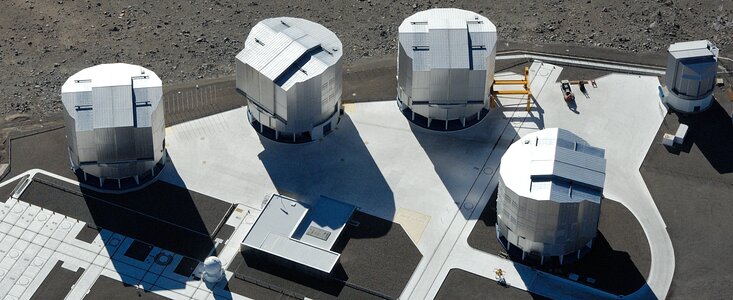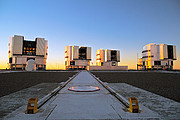Mitteilung
Zwei Jahrzehnte der Entdeckungen mit dem Very Large Telescope Interferometer der ESO: Herzlichen Glückwunsch zum Geburtstag, VLTI!
29. Oktober 2021
Heute vor 20 Jahren wurde zum ersten Mal das Licht zweier 8,2-Meter-Unit-Teleskope (UTs) des Very Large Telescope der ESO am Paranal Observatorium in Chile kombiniert. Es war ein historischer Moment, der durch dieses Ereignis markiert wurde: Zum ersten Mal arbeiteten diese Teleskope als echtes Interferometer und leiteten damit den Beginn einer neuen Ära in der Astronomie ein.
Als die Lichtstrahlen der beiden UTs in der Nacht des 29. Oktober 2001 zusammengeführt wurden, nahm das VLTI nicht nur erfolgreich seinen Betrieb auf, sondern lieferte auch erste wissenschaftliche Ergebnisse: die Vermessung des südlichen Sterns Achernar, der, wie sich herausstellte, ungefähr zehnmal so groß ist wie die Sonne. Darauf folgten drei weitere Nächte mit wissenschaftlichen Beobachtungen, bei denen das VLTI sein exzellentes Potenzial bei der Vermessung zehn weiterer Sterne unter Beweis stellte und die erste interferometrische Beobachtung des faszinierenden Eta Carinae vornahm.
Das erfolgreiche Konzept des VLTI war einige Monate zuvor, im März 2001, demonstriert worden: In dieser Nacht war das Licht eines anderen Sterns, dem hellen Sirius, gesammelt und mit zwei kleinen Teleskopen (so genannten Siderostaten) zusammengeführt worden, die speziell für die frühen VLTI-Test-Phasen konstruiert worden waren.
Das Kombinieren vom Licht der Siderostaten und später der UTs war erst der Anfang der Reise für das Interferometer. Das VLTI kann auch mit vier beweglichen Hilfsteleskopen (AT) von 1,8 Metern Durchmesser arbeiten, die zwischen 2004 und 2006 fertiggestellt wurden. Im Februar 2005 wurde erstmals Licht zweier ATs kombiniert – ein weiterer wichtiger Meilenstein im Leben des Interferometers. Die ATs führen ihr Licht auf ähnliche Weise zusammen wie die UTs, mit dem Unterschied, dass die ATs zu 30 verschiedenen Orten entlang der Paranal-Plattform bewegt werden können. Das ermöglicht eine ganze Reihe neuer interferometrischer Konfigurationen und erlaubt dem VLTI, sein Beobachtungs-Potenzial voll auszuschöpfen.
Durch die Integration des Lichts, das von den UTs oder ATs gesammelt wurde, kann das VLTI als ein „virtuelles“ Instrument mit einem Durchmesser fungieren, der so groß ist wie der Abstand zwischen den einzelnen Teleskopen („Baseline“ genannt). Das Interferometer wird aktuell mit Baselines von bis zu 140 Metern betrieben – abhängig von der Position der ATs. Als das Licht zweier UTs erstmalig im Oktober 2001 kombiniert wurde, lag die Baseline bei etwa 102 Metern, was es dem VLTI ermöglichte, Details auf der Oberfläche von Achernar mit einer Auflösung zu sehen, die der entspricht, wenn man ein vier Meter langes Fahrzeug auf dem Mond erkennt. Die Auflösung des VLTI zusammen mit der Fähigkeit der einzelnen Teleskope, Licht zu sammeln, lassen das VLTI zu einem der stärksten optischen Interferometer der Welt werden.
Dank dieser exquisiten Detail-Genauigkeit, hat das VLTI der ESO im Laufe seines 20-jährigen Betriebs dabei geholfen, viele Forschungsgebiete der Astronomie näher zu beleuchten. Forschung, die auf VLTI-Daten basiert, hat seit 2002 zu mehr als 450 wissenschaftlichen Publikationen beigetragen. Darunter sind bahnbrechende Erkenntnisse, wie etwa die 2020 mit dem Nobelpreis gewürdigten Beobachtungen von Sternen, die das supermassereiche Schwarze Loch im Zentrum der Milchstraße umkreisen. Oder auch die erste direkte Beobachtung eines Exoplaneten mit optischer Interferometrie, das besonders hochauflösende Bild des Eta-Carinae-Sternsystems, die Entdeckung von exozodiakalem Licht, das bislang beste Bild der Oberfläche eines Sterns und seiner Atmosphäre und die schärfste Sicht auf eine Staubscheibe um einen alternden Stern.
Das VLTI der ESO hätte all diese atemberaubenden Ergebnisse ohne seine erstklassigen Instrumente nicht erreichen können, zu denen auch die gehören, die aktuell in Betrieb sind – PIONIER, GRAVITY und MATISSE – und die zwischen 2010 und 2018 erstes Licht sahen.
Links
- „The Messenger“-Artikel über “first fringes” mit zwei VLT Unit Telescopes (Dezember 2001)
- ESO Presse-Mitteilung: Giant Eyes for the VLT Interferometer (November 2001)
Kontaktinformationen
Antoine Mérand
VLTI Programme Scientist
European Southern Observatory
Garching bei München
Tel: 089 3200 6630
Email: amerand@eso.org
Bárbara Ferreira
ESO Media Manager
Garching bei München
Tel: 089 3200 6670
Email: press@eso.org
Über die Mitteilung
| ID: | ann21015 |
Our use of Cookies
We use cookies that are essential for accessing our websites and using our services. We also use cookies to analyse, measure and improve our websites’ performance, to enable content sharing via social media and to display media content hosted on third-party platforms.
ESO Cookies Policy
The European Organisation for Astronomical Research in the Southern Hemisphere (ESO) is the pre-eminent intergovernmental science and technology organisation in astronomy. It carries out an ambitious programme focused on the design, construction and operation of powerful ground-based observing facilities for astronomy.
This Cookies Policy is intended to provide clarity by outlining the cookies used on the ESO public websites, their functions, the options you have for controlling them, and the ways you can contact us for additional details.
What are cookies?
Cookies are small pieces of data stored on your device by websites you visit. They serve various purposes, such as remembering login credentials and preferences and enhance your browsing experience.
Categories of cookies we use
Essential cookies (always active): These cookies are strictly necessary for the proper functioning of our website. Without these cookies, the website cannot operate correctly, and certain services, such as logging in or accessing secure areas, may not be available; because they are essential for the website’s operation, they cannot be disabled.
Functional Cookies: These cookies enhance your browsing experience by enabling additional features and personalization, such as remembering your preferences and settings. While not strictly necessary for the website to function, they improve usability and convenience; these cookies are only placed if you provide your consent.
Analytics cookies: These cookies collect information about how visitors interact with our website, such as which pages are visited most often and how users navigate the site. This data helps us improve website performance, optimize content, and enhance the user experience; these cookies are only placed if you provide your consent. We use the following analytics cookies.
Matomo Cookies:
This website uses Matomo (formerly Piwik), an open source software which enables the statistical analysis of website visits. Matomo uses cookies (text files) which are saved on your computer and which allow us to analyze how you use our website. The website user information generated by the cookies will only be saved on the servers of our IT Department. We use this information to analyze www.eso.org visits and to prepare reports on website activities. These data will not be disclosed to third parties.
On behalf of ESO, Matomo will use this information for the purpose of evaluating your use of the website, compiling reports on website activity and providing other services relating to website activity and internet usage.
Matomo cookies settings:
Additional Third-party cookies on ESO websites: some of our pages display content from external providers, e.g. YouTube.
Such third-party services are outside of ESO control and may, at any time, change their terms of service, use of cookies, etc.
YouTube: Some videos on the ESO website are embedded from ESO’s official YouTube channel. We have enabled YouTube’s privacy-enhanced mode, meaning that no cookies are set unless the user actively clicks on the video to play it. Additionally, in this mode, YouTube does not store any personally identifiable cookie data for embedded video playbacks. For more details, please refer to YouTube’s embedding videos information page.
Cookies can also be classified based on the following elements.
Regarding the domain, there are:
- First-party cookies, set by the website you are currently visiting. They are stored by the same domain that you are browsing and are used to enhance your experience on that site;
- Third-party cookies, set by a domain other than the one you are currently visiting.
As for their duration, cookies can be:
- Browser-session cookies, which are deleted when the user closes the browser;
- Stored cookies, which stay on the user's device for a predetermined period of time.
How to manage cookies
Cookie settings: You can modify your cookie choices for the ESO webpages at any time by clicking on the link Cookie settings at the bottom of any page.
In your browser: If you wish to delete cookies or instruct your browser to delete or block cookies by default, please visit the help pages of your browser:
Please be aware that if you delete or decline cookies, certain functionalities of our website may be not be available and your browsing experience may be affected.
You can set most browsers to prevent any cookies being placed on your device, but you may then have to manually adjust some preferences every time you visit a site/page. And some services and functionalities may not work properly at all (e.g. profile logging-in, shop check out).
Updates to the ESO Cookies Policy
The ESO Cookies Policy may be subject to future updates, which will be made available on this page.
Additional information
For any queries related to cookies, please contact: pdprATesoDOTorg.
As ESO public webpages are managed by our Department of Communication, your questions will be dealt with the support of the said Department.




